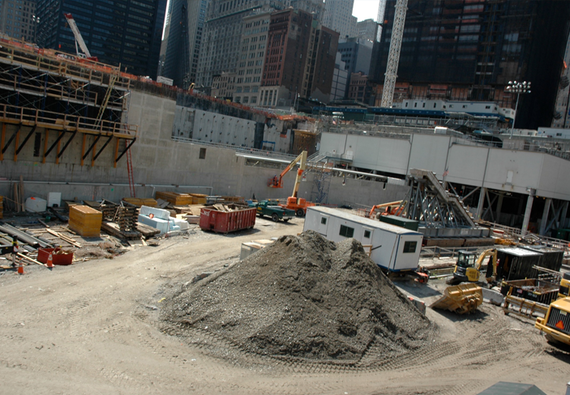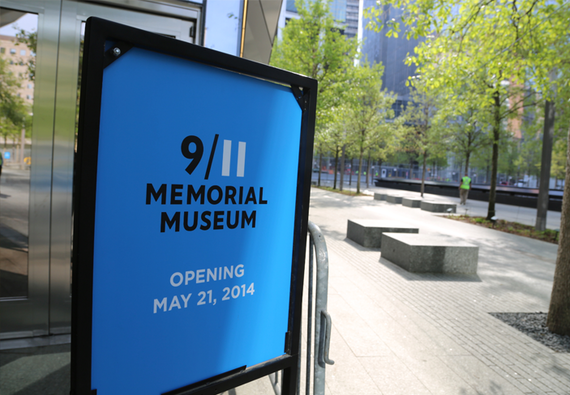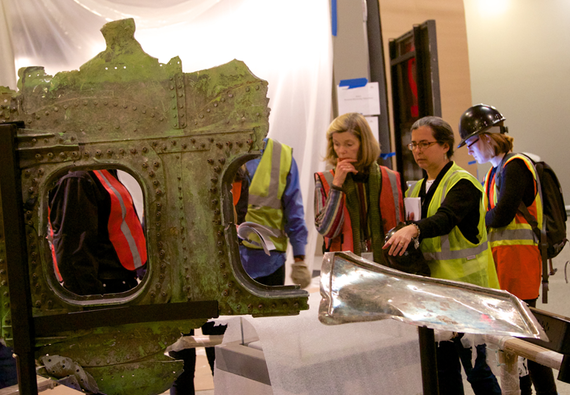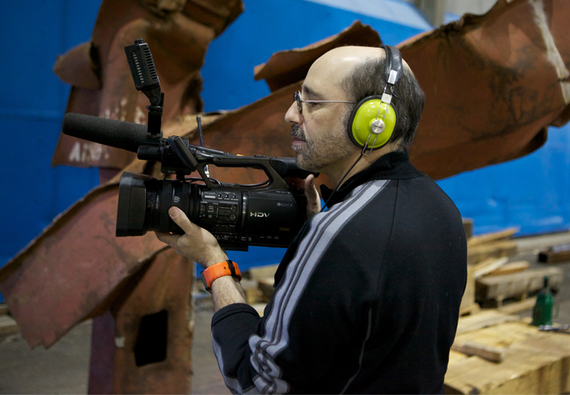(Video at bottom.)
In 2006, I entered the site of the World Trade Center attacks for the first time since the night of 9/11.
It's hard to explain what it felt like being there.
It was a construction site, full of hard hats, and steel beams, and the flurry and promise that something new would rise on the site.
At the same time, it was a place full of overwhelming emotion. The memories of 9/11 -- the dark nights, the smoke and flames, the piles of debris, and the knowledge that New Yorkers of all religious beliefs and nationalities had lost their life -- hung in the air. 
In many ways the future of New York, and of a tolerant and interconnected world, seemed to hang in the balance. I tried to capture that feeling and the triumphant survival in my film 7 Days In September.
When I made the decision to donate to the Museum the rights to what was then the world's largest 9/11 Archive, I did so with both hope and some trepidation.
It was 2006 and the New York Times wrote about the importance of the Archive, and its value to future generations.
Back then, with the fifth year anniversary approaching, I told the Times that the Archive "contains things that we don't know, right now, that we need to know. We don't know why these things need to be preserved. But we know they need to be."
Back in 2006, Jan Ramirez, chief curator of the World Trade Center Memorial Foundation, said: It is "an extraordinary compilation of perspectives, a very important archive to keep together."
Thanks to Jan, and her colleagues, we did.
Now, seven years later, the pit has been replaced by Michael Arad's Memorial, but what has been essentially invisible to all but a very few has been the painstaking process of gathering, curating, and preparing the Museum that President Obama will dedicate today at the site of the World Trade Center.
The challenges that have faced the team can't be underestimated. Engaging a subject that is widely accepted as the most photographed and documented event in world history required a bottomless well of compassion and an endless stream of difficult decisions. The result is a massive, underground museum that will provide visitors and historians alike with access to a level of detail that is hard to imagine. The complexity of the editorial efforts can best be explained with a look at the diversity of the visitors who will stream through the museum's galleries. There will be the families of those who lost their life now almost 13 years ago. They remain grief-stricken, their feelings still raw and exposed. Then, there will be the New Yorkers, all of whose lives were touched in some way, and many who are anxious to "move on." In large numbers, there will be visitors from outside the city, and even the country -- people who span the gamut, from serious students to curious visitors. And finally children, both English speaking and not, whose exposure to 9/11 has been sparse for the most part.
My family will have members in a number of categories. My wife and I were close to the site as you could be in the days just after the attacks. My older son was just 12, so for him 9/11 colored his entire teenage years in New York. And for my younger son, he was just 4-years-old; 9/11 was something he doesn't remember, but yet it is very much part of his life.
Over the past seven years, I've been allowed to observe and document the process of conceiving, curating, building, and now opening to the public the National 9/11 Memorial Museum. My images and recordings span seven remarkable years -- the results of which will be available to the public when the museum opens on May 21st. But what you won't see is what it took to bring this project to completion. So, today I thought it right if I shared four important observations about the museum that may help you understand the project and the result.
What Actually Happened?
Watching the team focus on minute details -- double and triple checking facts, carefully adjusting the periods, commas, and cadences of every word -- one thing is clear to me: Alice Greenwald and her team understand the importance of this museum as the final resting place of the memories and facts of 9/11. While some may question how the story is told, there's been no shortage of input and dissenting voices in the process. The facts, as we know them today, are reported in stark and often emotionally powerful voices.
Who Are These People?
Around the table, for years, there's been a respectful but often disparate series of points of view. What should be used to tell a story? Pictures? Words? Voices? Scholars, or survivors? Family members, or political Leaders? With meticulous care, each and every option was measured and balanced to reach a consensus on even the minutest details. Alice Greenwald comes from the Holocaust Museum in Washington DC. The Chief Curator, Jan Ramirez, comes from the New York Historical Society. Michael Shulan, the Creative Director, was the man behind This Is New York, a crowd sourced photo project that embraced the communal nature of the documentation. Then there are architects, museum exhibit designers, and electronic display producers and directors. They represent a wide spectrum of political and aesthetic points of view. They often disagree passionately, but in the end the decisions are arrived at collectively and with the spirit of a shared objective to tell the truth.
Is There an Agenda?
Greenwald is quick to point out that this is a living museum, which is to say that the curators understand the complex nature of putting a period on a sentence that is by no means finished. Clearly historians agree that the events of 9/11 are a demarcation point in both U.S. and world history, but the final chapter is far from being written. If there's any agenda at all, it was to keep the museum from being the work of any single politician or political perspective. As such, probably every visitor will find something about the telling of the story that will make him or her a bit uncomfortable. As it should. The exhibit doesn't embrace a singularly "American" point of view; so, flag waving -- while patriotic -- isn't the mission of the exhibition. The names and faces of those who lost their lives are presented in a way that is both respectful and dynamic, with the voices of their loved ones telling their stories. But the museum's curators know many 9/11 stories have yet to be told, and so the end of the public's visit includes a recording booth so each and every visitor can choose to add his or her voice to the museum's collection.
What Will You Take Away From the Museum?
Everyone will bring their own version of 9/11 as they enter the pavilion. Whether you smelled the acrid and unforgettable smoke in lower Manhattan, or you watched it on TV. But whatever you bring, you'll leave with more than you brought. Because the 9/11 story is so impactful, emotional, and personal -- you can expect to be caught by surprise. For me, the story that caught me by surprise was in one of the alcoves -- small private spaces that are kept off the main walkway -- with the clear understanding that not everyone will want to be exposed to these sounds and images. It was the recording of the passengers on the plane -- leaving voicemails that were both calm and clearly meant as last words for the families of what passengers now knew would be their final communications home, "Don't worry, I'm fine" one mom recorded on her family's home answering machine. "I love you."
Seven years is a long time. New York has a new mayor. The fences are about to come down from around the World Trade Center site. Trees are blooming. The sky is blue. But it's not about moving on, or forgetting. It's about remembering, learning, growing. And whatever your point of view or political perspective, a visit to the National 9/11 Memorial and Museum is sure to provoke that. That's something I'm proud to be a part of.




